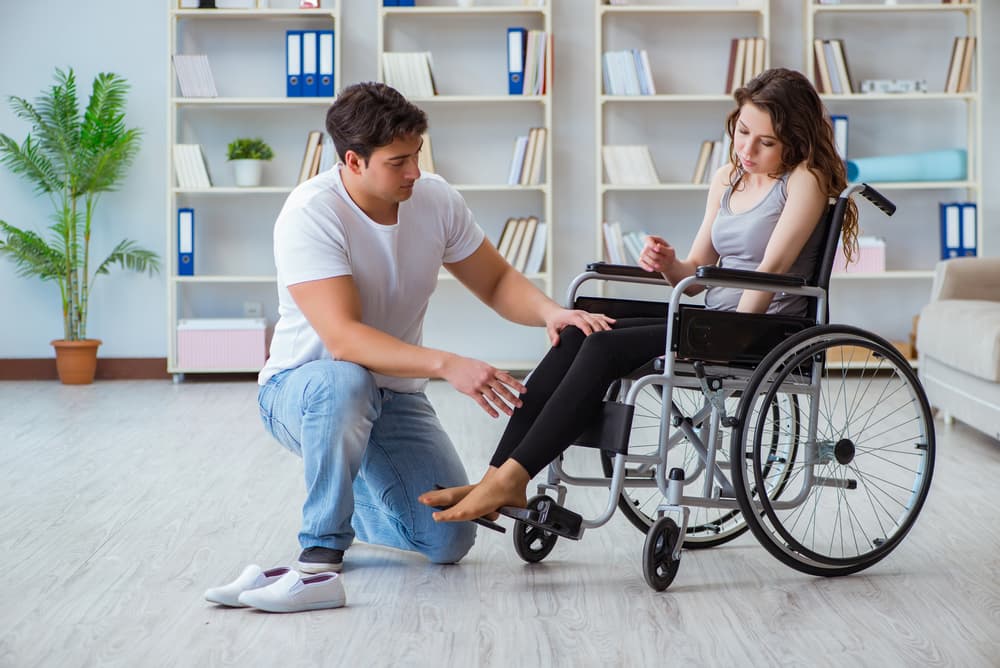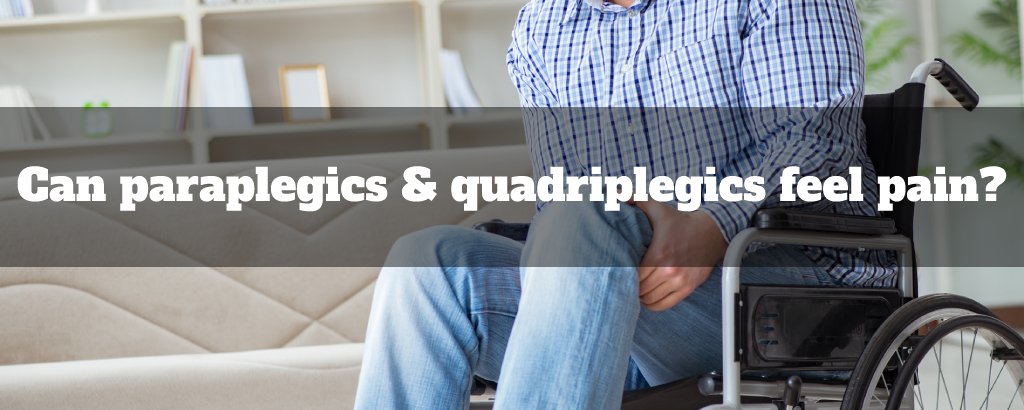Spinal cord injury causes many changes in the body of the person experiencing it. And chronic pain is a major secondary complication of spinal cord injury (SCI), with 65 to 85% of SCI patients reporting serious pain problems.
Pain can be felt above, above, or below the area of the SCI, and it can last for years after the initial injury has recovered. Pain can be felt instantly after the injury or may develop or worsen over time.
Chronic pain can be challenging to manage in people with spinal cord injuries and significantly impact their quality of life.
Why can paraplegics feel pain?
Damage to the nerves in the spinal cord can cause paralysis—the inability to move or feel particular regions of the body—as well as excruciating pain.
Our nerve cells are responsible for our perception of pain. The signals are transported with a special chemical known as a neurotransmitter. GABA (gamma-aminobutyric acid) is very low in damaged spinal cord lesions. This “disinhibits” pain-sensitive spinal neurons.
According to recent findings, there may be a deficiency of the other neurotransmitter, norepinephrine, and an excess of the neurotransmitter glutamate.
Some with spinal cord injuries may feel pain in several locations, including those that have lost all sensation.
Types of Pain

Pain can manifest in numerous forms and locations for a person with Spinal cord injury, including in areas that generally have no sensation. Pain can occur in several ways.
Neuropathic pain
Neuropathic pain is one of the most challenging conditions to treat in people with paraplegia, with 40% suffering from it. With quadriplegia, neuropathy pain is less common.
Neuropathy or central pain syndrome happens when the brain “misinterprets” signals from an injury, leading a person to assume the source of pain is deep within the body, even if such a sensation has been lost.
The tolerance for neuropathic pain varies from person to person. Various descriptions include “burning,” “stringing,” and “stabbing” sensations. There is no cause for this pain, and victims may suffer it with little to no notice.
Other inconveniences, such as pressure ulcers or fractures, may aggravate neuropathic pain.
Below-level neuropathic pain. It is a type of pain felt below the level of injury, typically on both sides of the body, but with the same penetrating, stabbing, and electrifying nature as the first type of neuropathic pain.
Visceral Pain
Visceral pain, which is also called referred pain, is usually caused by undiagnosed digestive problems like ulcers, kidney stones, constipation, or appendicitis.
The discomfort is reported as continuous, burning, and cramping; its prevalence is estimated to range from 5% to 10.6%.
If no stomach problem or disease can be identified, the abdominal pain is attributed to neuropathic pain caused by incorrect nerve signals.
Musculoskeletal Pain
Musculoskeletal pain is the type of pain experienced by everyone. Problems in the muscles, joints, or bones are the root of musculoskeletal pain and are common in people with spinal cord injuries, which affect almost 59% of people.
Different kinds of musculoskeletal pain occur.
- Muscle Spasm pain – is caused by painful involuntary movements (spasms) of an immobile or partially-mobile body part. Muscle tightness may induce painful joints in return.
- Overuse Pain – Often, this occurs in individuals with an SCI because only one muscle group is always utilized. It may happen in the arm or shoulder, for example, due to pushing a manual wheelchair.
Shoulder pain, elbow pain, and hand pain are common in people with spinal cord injuries due to the strain of using a wheelchair and assisting with transfers, making it difficult to move and conduct other daily tasks securely.
- Back/Neck Pain – Neck pain occurs in people who have had spinal fusion surgery and might result from increased mobility immediately above and just below the fusion.
Psychological Pain
Age, depression, stress, and anxiety are all connected with heightened pain after a spinal cord injury. Pain is real, but it also seems to have an emotional side and can worsen psychological problems.
Expert’s Opinion About Chronic Pain
Dr. David Chen, MD, explains the cause of pain in people with spinal cord injuries. Because the impulses from that area of the body back to the brain are blocked after a spinal cord injury, the brain begins to produce its signals to compensate for the absence of signals from the body. Causing neuropathic pain explained above.
The doctor explains the connection between pain and a spinal cord injury in this video. She says that the spinal injury has damaged the nervous system, creating an abnormal system for pain perception. That is why there are certain areas where the pain is felt.
This video explains what surgical procedures can be used for severe pain in people with paraplegia. Dr. Scott Felgi performed pain reduction surgery on a patient and found that by killing the hotspots of overreacting nerve cells in the spinal cord, he could reduce sharp, burning, and stabbing pain sensations by 85%. John Forbes, for whom this surgery was performed, says he is happy and satisfied with the surgery as it gave him hope to live with less pain.
Stuart Bunt, a professor of neuroscience and anatomy, shares his expert opinion that there are various ways we might alter the experience of pain, and the sensation itself is very subjective. Multiple methods, including medication, surgery, electrical stimulation, antidepressants, hypnosis, and acupuncture, can alleviate pain.
Real-Life Examples of People with Spinal Cord Injuries & Pain
Kayla Lea, a c6 quadriplegic, only feels ‘pain’ in the outer parts of her arms, shoulders, neck, and head. But she doesn’t feel any pain when she repeatedly bounces her leg against the wall. Even though she didn’t feel pain when she once had sepsis on her leg, realizing something was wrong when she had an episode of autonomic dysreflexia.
Tom Wolford, 60, of Roseburg, Oregon, claims he has suffered neuropathic pain since his C6-7 injury, but he refused pain medication when provided. “I didn’t want to get dependent on it,” he explains. In addition, he characterizes his discomfort as a continuous burning and tingling feeling. “Occasionally, one or two aspirin are sufficient to alleviate discomfort,” he adds.
Dustin Mesa, who has paraplegia, shares his view about the pain management regimens he has had through the years. He had recently started getting chiropractic adjustments for himself and saw better results. He suggests massage therapy, acupuncture techniques, and hot and cold baths for nerve and muscle spasm-related pain. He also emphasized having strength training and posture checks to relieve musculoskeletal pain.
Joe Stillmans, a quadriplegic, says his pain did not start until three months after the accident. It began in the big toe, with the sensation that it had slipped through a hole in his sock. It is a weird pain since it has no apparent pattern. There do not appear to be any specific pain triggers; nonetheless, some days are better than others. On a personal level, he takes medicine prescribed by the doctor, but he also finds that keeping himself occupied and distracted from the pain is beneficial. Exercising and utilizing his standing frame are two of the most effective distractions.
What Treatments Are Available for Pain Following a Spinal Cord Injury?

Each SCI patient with persistent pain should have a strategic sci and pain management regimen. As there are no defined causes of pain, a multidisciplinary approach to treating it can be used. Such as,
Medication
Pain medications are commonly recommended to treat musculoskeletal pain, and there are a few types that doctors have proven to be particularly effective in reducing and treating pain.
- Spasm-related and musculoskeletal pain are treated to reduce muscle pain tension using muscle relaxants and anti-spasticity drugs, including diazepam (Valium), baclofen (Lioresal), and tizanidine (Zanaflex). These can be injected into the spinal column or taken orally.
- NSAIDs such as aspirin, ibuprofen (Motrin, Advil), and naproxen are also used to treat musculoskeletal pain.
- Anticonvulsant drugs are also found to be beneficial. Pfizer’s 2012 anticonvulsant was approved for treating spinal cord injury pain (SCI). Pregabalin, also known as Lyrica, was found to be more effective, with a 30%-50% decrease in pain intensity.
- While antidepressants and opioids have shown some success in treating neuropathic pain, it’s important to remember that they come with their hazards, including the potential for addiction.
- Light touch pain is typically treated with topical local anesthetics such as lidocaine (Lidoderm).
Although pain medications might be very beneficial, they rarely get to the root of the problem. Therefore, pain relief is typically just short-term, and medications might not be the best choice for long-term chronic pain management.
Botox
It has been suggested that Botox injections might help ease the neuropathic pain that often follows a spinal cord injury. One study indicated that after receiving Botox, roughly 50% of those with severe neuropathic pain reported a 20% or greater reduction in pain for at least eight weeks.
It functions by inhibiting the transmitters that induce muscular contractions. Botox is directly injected to treat painful muscles, and its effect lasts 3-6 months.
Individuals with SCI can achieve long-term pain relief by taking advantage of reduced stiffness by botox and focusing on establishing new nerve connections through physical therapy.
Physical Therapy
Pain relief from a spinal cord injury can also be achieved through physical therapy. Stretching contracted muscles reduces muscle tension, strengthens weak muscles to treat neuropathic pain, and increases joint mobility.
Many physical therapists advise doing various motion exercises to improve blood flow and prevent joint stiffness, which helps with the body’s pain control system.
Exercises
Mild to moderate exercise like walking or swimming can boost your mood by increasing oxygen and blood flow to your muscles and reducing muscle tension and fatigue. Exercise helps reduce the stress associated with pain, which makes the pain worse.
As per research, people with SCI who participated in a regular exercise program reported decreased levels of depression and pain.
Always consult a physical therapist before beginning any exercise regimen, as the wrong exercises may worsen the pain.
Electrical Stimulation
Electric currents block pain signals and boost endorphin release, reducing the brain’s perception of pain.
Transcutaneous electrical nerve stimulation (TENS) can relieve muscle and joint pain but works less well below the injury level.
Transcranial electrical stimulation (TCES) uses scalp electrodes to stimulate the cerebrum. This newer technique is believed to be effective in treating musculoskeletal pain.
If these methods fail, then surgical procedures are considered for managing pain.
Supplements & vitamins
Doctors have recognized Omega-3’s relevance for brain and spinal cord health in recent years. Even in the case of spinal cord injuries, a few studies back up the idea that daily consumption of Omega-3 fatty acids might alleviate the pain associated with the condition.
Taking your daily multivitamins is also beneficial since calcium and vitamin D are essential for bone and spinal cord health.
Surgical Methods
When an injury causes neuropathic pain to a nerve root, a dorsal column stimulator can help a lot. Surgical implantation with a high-frequency, low-intensity nerve stimulator to activate the spinal cord or nerve roots.
The aim is to relieve pain by 50–70%, but even a little reduction in pain can improve your quality of life by allowing you to resume normal activities and reduce medication use.
Another method that is used to treat pain is an intrathecal pump. A pump carrying morphine or baclofen is surgically implanted inside the abdomen. The drug is delivered straight to the spinal cord and nerve roots.
Alternative Therapies
A handful of other treatments have been found to be effective.
- Acupuncture – According to certain studies, acupuncture has been found to stimulate the body’s painkillers, the endorphins. Medical professionals are coming to acknowledge its effectiveness in reducing the pain associated with spinal cord injuries and enhancing recovery.
- Psychotherapy – Therapy can help you learn to cope with the pain associated with a spinal cord injury; by doing so, you may suffer less pain overall.
- Biofeedback – Self-management of pain can be improved with biofeedback designed to educate you to relax muscles and release neuropathic and musculoskeletal pain.
- Cognitive behavior therapy (CBT) – Attending to your mental and physical health is essential if you hope to recover from chronic pain. So, CBT has been a treatment choice in his case.
Changes in brain activity and the feeling of pain can be brought about by learning how to reframe one’s perspective on pain and its consequences. - Yoga – By strengthening the mind and body, yoga can assist those with spinal cord injuries manage their emotional and physical pain. Regular yoga can play an essential role in the rehabilitation, facilitating the return to full mobility and independence.
- Try Cannabis – There is evidence that cannabinoids can modify how the brain processes pain by activating receptors in the central nervous system. Chronic pain associated with spinal cord injuries was shown to be significantly reduced when cannabis was combined with massage in a 2006 research.
The therapeutic benefits of alternative therapies for SCI pain seem to be hit or miss due to the lack of standards in the field. But given how inexpensive they are compared to medications and how few adverse effects they really have, it’s still worth a shot.
Prevention is better than cure
People frequently want total pain relief but grow more adaptable by understanding that pain is a part of daily life and cannot be eliminated. The ability to accept one’s pain as normal has been shown to positively affect several studies.
The following methods can also be used to understand pain management better.
A state of health
The state of health as a whole can have a significant effect on pain. A good diet, a healthy weight, and regular physical activity boost general health.
Pain might worsen or be more difficult to cure if you are fatigued, have recurring urinary tract infections, or do not get enough sleep.
Distraction is the key
Participating in enjoyable and meaningful activities can help reduce pain and help you feel more in control of your life, especially when pain is at its worst.
Keep up a record
Everyone’s pain is unique. Keep track of what reduces your sci pain and what makes the pain worse. Understanding the factors that influence your pain will aid you and your physician identify successful pain relief strategies.
Wheelchair Adjustments
Poor posture and improper wheelchair technique might result in significant upper limb pain issues. Learn from a physical therapist the suitable wheelchair propelling (pushing) technique. It is also suggested to get a wheelchair seating assessment.
Alcohol isn’t a treatment
Using alcohol as a pain management treatment can result in alcoholism and other serious issues.
Also, certain medications don’t go well with alcohol. So always consult your GP to get a complete assessment of chronic pain management.
Sustaining a spinal cord injury can leave you in constant agony, impacting your ability to work, enjoy, and socialize. Fortunately, there are effective ways to ease difficult chronic pain problems allowing people to focus on making progress.
Before you go
A direct injury to the spinal cord or damage to the tissue and bones surrounding the spinal cord can cause a spinal cord injury. This damage may result in temporary or permanent changes to sensation, movement, strength, and other functions below the injury site. Read my article to learn more about how a spinal cord injury can affect the body.

